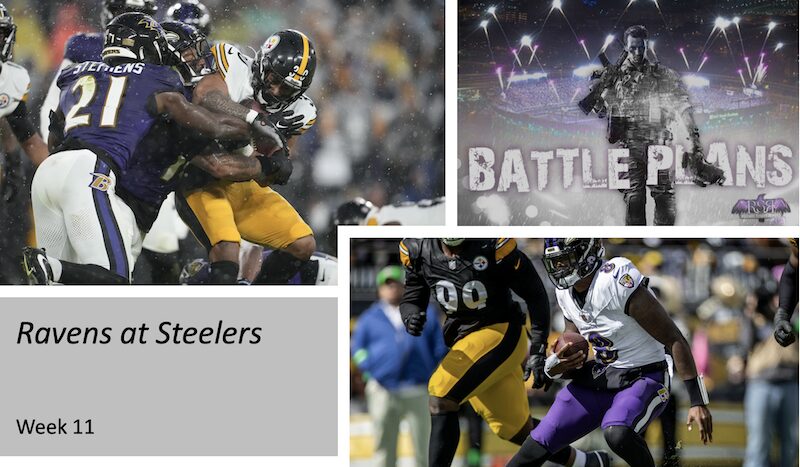Dev Panchwagh contributed to this article
Offense
Spread Out and Run
The Ravens proved that league rankings don’t matter against their high-octane offense in their Week 9 win over the Broncos. They’ll attempt to duplicate that effort against a Steelers defense that ranks among the top four in rushing yards per game (87.1), rushing yards per play (3.8), explosive rushes (23), stuff percentage (21.0%) EPA/rush (-0.20), and rush yards over expected per attempt (-0.63). However, Pittsburgh gets closer to league average when operating out of light boxes, which they do 44.9% of the time.
Baltimore should exploit that discrepancy by spreading out their offense and running the football, which was one of their most successful strategies last season. They haven’t been especially efficient rushing against light boxes this year, but their fifth-ranked 2.92 yards before contact per carry indicates that the scheme is at least creating space.
With Isaiah Likely trending towards a return on Sunday, the Ravens can get back to their spread two-tight end sets with Likely inline and Mark Andrews in the slot, which will help draw the Steelers into light boxes. Those blocking mismatches on the outside have helped the Ravens lead the league in rushing efficiency outside the tackles, though the Steelers defense has been excellent there as well. Todd Monken should mix in jet sweeps with Zay Flowers – and potentially Tylan Wallace as an unexpected change-up – and designed QB runs to attack the edges in a variety of ways. Getting the Steelers moving laterally will also set up under center runs by Derrick Henry later in the game.
If Pittsburgh insists on stacking the box against the Ravens’ run game, Monken should trot out 20 personnel with Patrick Ricard lined up as an inline tight end as a sneaky way to get three receivers on the field while preserving a blocking advantage.
Toss plays to Henry have been one of the Ravens’ most effective plays this year, but recent opponents have sold out to stop it. It’s an effective way to attack light and stacked boxes outside the tackles, but Monken should design a counter that gives Henry blocks to cut back to the left like he did against the Buccaneers.
Quick Hitters and YAC
The Steelers have been less efficient against the pass, but still rank 12th with a -0.10 EPA/pass allowed. However, they have struggled against quick passes (0.25 EPA/pass allowed) and passes under 10 yards (0.10 EPA/pass allowed) while allowing 232 yards after the catch over expected, the fifth-most in the NFL despite the lowest missed tackle rate in the league.
That indicates a scheme issue against quick passes into space, something the Ravens should look to exploit. Baltimore leads the NFL with 0.40 EPA/pass on throws under 2.5 seconds and ranks second with 0.23 EPA/play on throws under 10 yards, with top-three ranks in YAC and YACOE in both situations.
Much of that success has come via a resurgence of the Ravens’ screen game, which has been especially effective against the blitz. The Steelers have the 10th-lowest blitz rate in the NFL, but they’re still at 24.2% and will provide opportunities for screens. Monken should also design his screens to be effective against non-blitzes, like the play action screens that fake in one way before throwing another with blockers out in front. Likely’s return could be a factor here as well, both as a blocker and receiver on tight end screens.
Screens are not the only way to scheme up quick passes that pick up yards after the catch. Spread formations can be used in concert with the run game, along with stack and bunch formations that create traffic off the line of scrimmage and allow pass-catchers to release into space.
Flowers has excelled in motion this year on shallow crossers and out routes that allow him to use his start-stop abilities to separate from defenders before and after the catch. Monken should deploy route combinations that clear out roving safeties and linebackers to let Flowers dance away from his matchup and maximize his YAC potential.
Another creative idea could be to design a few plays with Diontae Johnson as the primary read on screens and rub routes. Despite their familiarity with his talent, the Steelers, according to Mike Tomlin, are focused on the more established pieces of the Ravens offense. Johnson will be motivated in his return to Pittsburgh and will be looking to fight for yards with the ball in his hand. Scheming up designed touches for him could be a way to surprise his former team early on.
Turn Down the Wattage
T.J. Watt will become a familiar foe for Roger Rosengarten, and hopeful he will grow into the challenge as he develops. As a rookie, though, he can’t be expected to corral the four-time All-Pro on his own.
Using motion and designed QB runs will create traffic for Watt and force him to slow down and process what’s in front of him. Quick passes and runs to the left side are also an effective way to take him out of the game.
However, Monken won’t want to restrict his playbook all game, nor will he be able to in obvious passing situations. The Steelers’ 13.6% blitz rate on third downs is a league-low; they prefer to turn Watt loose when they know opponents are throwing the ball.
It’s difficult to double-team edge rushers with two offensive linemen, and the Ravens shouldn’t complicate things for Daniel Faalele, especially with Cameron Heyward, Larry Ogunjobi, and Keeanu Benton to handle on the interior.
Instead, it will be the tight ends and running backs, who have been used in pass protection at one of the highest rates in the NFL. The extra blockers have given Lamar Jackson enough time to create magic with his arms and his legs. Typically, it has been Justice Hill, who excels as a physical pass blocker but sometimes struggles to pick up exotic blitz designs. By simplifying his assignment to doubling Watt, the Ravens can harness his ability to fight hard throughout the play.
Henry and Ricard also have the two best pass-blocking grades on the team, with zero pressures between them in 58 snaps, per Pro Football Focus. Henry has the power to stop Watt in his tracks in the backfield and Ricard can work as a pseudo-sixth offensive lineman and double Watt off the snap. Using them as secondary options for extra pass protection will allow Andrews and Likely to run more routes and do more damage through the air.
Ronnie Stanley struggled against Trey Hendrickson and Myles Garrett this season, but he’s put the clamps on every non-elite edge rusher he’s faced. Preston Smith and Nick Herbig represent solid talents at opposite ends of the age and experience spectrum, but Stanley should be trusted to handle them on an island with more resources directed towards Watt.
Defense
Force Harris Outside
Najee Harris is having another inefficient season in Pittsburgh, with 4.1 yards per carry, -0.08 EPA/rush, and a 35.0% success rate that ranks 14th out of 46 ballcarriers with at least 60 attempts. He’s still getting it done with volume, though, averaging a career-high 71.7 yards per game.
As a result, the Ravens’ run defense should be able to continue its success against Harris, who runs from under center 75.2% of the time, the fifth-most in the league. However, the Steelers’ 30.6% play action rate is fourth-highest in the NFL, so Roquan Smith and Trenton Simpson will need to avoid getting sucked in by play fakes.
Harris has always been better rushing inside the tackles, and he’s even been slightly worse against light boxes as opposed to stacked boxes.

The defensive line should be focused on holding the A and B gaps on the interior while edge defenders keep him from turning upfield. With Michael Pierce still on IR, Brent Urban, Josh Tupou, and Broderick Washington will need to step up on early downs to keep the Steelers behind the sticks.
The Ravens should also use light boxes with their linebackers shaded towards interior run defense on early downs to discourage inside runs and make Harris bounce outside. He’s at his best as a downhill, physical runner, so forcing him to look for space laterally will slow him down.
If the Ravens succeed in forcing outside runs, they will need their edge and slot defenders to finish the job by bringing Harris down before he has a chance to turn upfield. Marlon Humphrey and Kyle Hamilton have both made impact plays against the run this year and should be trusted to continue their efforts, whether at the point of attack or pursuing Harris from the back side of the play.
Man Up
The Ravens refused to run more man coverage and double-cover Ja’Marr Chase last week, and it nearly cost them the game. Mike Macdonald loved to run exotic disguised coverages to confuse and bait opposing quarterbacks, but the secondary has not been nearly as sharp since Dennard Wilson left for Tennessee. Zone coverage will still be a part of the game plan, but Zach Orr should turn to man coverage in high-leverage passing situations. Against Justin Fields, the Ravens may want to keep their eyes on the quarterback in zone, but Russell Wilson is not nearly as much of a threat to run.
The splits against the Bengals were stark:
Joe Burrow vs. Ravens' zone coverage (68.3%): 27-of-37, 368 yards, 3 TDs, 131.4 passer rating
Joe Burrow vs. Ravens' man coverage (31.7%): 7-of-19, 60 yards, 1 TD, 63.5 passer rating
— Ryan Mink (@ryanmink) November 8, 2024
Man coverage will prevent blown assignments and miscommunications from continuing to bring down a unit that’s actually pretty talented! Brandon Stephens excels in press-man when he can use physicality and the sideline to stymie his matchup, and Marcus Williams is at his best as a deep safety helping over the top. Roquan Smith and Trenton Simpson can focus on running backs and tight ends instead of being overmatched by wide receivers operating over the middle.
Man coverage will also help the Ravens shade towards George Pickens, who has more receiving yards than the Steelers’ second- and third-leading pass-catchers combined. He has been especially effective on deep passes since Wilson took over at quarterback. Pickens leads the NFL with 11 catches and 370 receiving yards on targets over 20 air yards, with five deep receptions for 164 yards with Wilson under center. That’s the second-best deep connection between a QB and receiver this year despite just three games together.
Stephens has held up against Pickens in the past, and Wiggins has the speed, length, and attitude to stick with him as well, but that doesn’t mean the Ravens shouldn’t give them safety help over the top. Pickens isn’t at the same level as Chase, but he commands a similar target share in Pittsburgh’s offense. Slowing him down will eliminate their biggest passing weapon and force lesser players to step up.
Get Russ On The Run
The Steelers have allowed the seventh-highest pressure rate (38.4%) and the ninth-highest sack rate (8.9%) in the NFL this year. That is partially because they have faced the fourth-highest blitz rate (35.1%) in the league.
Still, all of that pressure has forced Pittsburgh’s quarterbacks to try to make plays on the run. 22.6% of Wilson’s passes have come outside the pocket (third-most) and 31.8% have come on the run (most), but his passer rating is one of the lowest in the league in those situations.
The Ravens should work to flush Wilson out of the pocket and force him to extend plays behind the line of scrimmage where he struggles. Their pass rush took a significant leap forward with Travis Jones back in the lineup, as opposing offensive lines cannot double both him and Nnamdi Madubuike. All that focus on the interior opens up more opportunities for the edge, too.
The pass rushers can get Wilson on the move in their individual matchups: on the interior, Jones and Madubuike can collapse the pocket and keep Wilson from stepping up, and Odafe Oweh and Kyle Van Noy can use inside pass-rushing moves to force the QB to the outside.
Orr should also dial up pressure with blitzing linebackers and inside loops from edge rushers to create traffic on the interior and force Wilson to take sacks or start running. Then, underneath defenders like Simpson, Kyle Hamilton, and Ar’Darius Washington can use their closing speed and open-field tackling to trigger on Wilson when he escapes the pocket, much like Simpson did against Bo Nix in Week 9.
1-on-1 Matchup
Tyler Linderbaum vs. Patrick Queen
Usually, a center’s main matchup is a defensive tackle. Though the Steelers have a solid trio, it will be Tyler Linderbaum’s success against his former teammate that will help keep the Ravens offense moving.
Patrick Queen will be looking to disrupt his ex-team’s offense on Sunday by trying to penetrate the backfield in run defense and the pass rush. Linderbaum has the short-area quickness to pick up and mirror Queen as a blitzer while climbing and sealing blocks against him on the second level.
Queen will also try to sniff out screens, though the Ravens can put him in a bind using RPOs. That will give Linderbaum time to get to Queen whether it be a run or pass, though the ball has to come out on time to avoid penalties. On standard screens, Linderbaum has to out-maneuver Queen and get him on his heels to keep him from blowing up the play before it can get going.
This is a fun matchup between two athletic, hard-nosed players. If Linderbaum can limit Queen’s ability to wreak havoc, the Ravens should be able to dominate the middle of the field on Sunday.
All advanced stats via Next Gen Stats unless otherwise noted.











One Response
Just run the football. Everything else stems from there. Use Mitchell to run the legs off of them, have Lamar drive the ball downfield anytime he throws, run the legs off the defense, then bring in Henry. Whistle or no Whistle hit Watt. After that, hit him again and he’ll get himself ejected. Hit Mike Tomlin. If flagged just say you heard him running his mouth and missed your intended target and hit him. When he gets up hit him again. After that have Ricard hit Queen, a lot. Keep hitting them, Whistle or no Whistle, knock the slobber right out their mouths (a few teeth too). The most physical team wins! So, you know what? Hit him again!